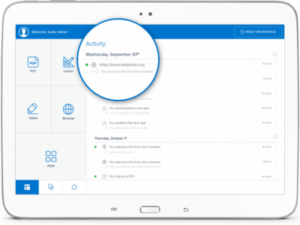At both ISTE 2015 and InfoComm 2015, it was evident that device/display sharing is quickly becoming all the rage.

For those less familiar with this arena, device/display sharing technology is designed to integrate visual control for the array of devices, platforms and technologies schools now use. And that’s a very good thing—to leverage the effectiveness of the babylon of display devices now in schools and colleges. Besides, this technology offers a number of teaching advantages for the 21st century classroom:
- Images, video, audio, or reading content becomes shareable cross-platform, cross-device.
- Student work can be shared on any display, with the whole class or peer-to-peer.
- The teacher can send learning to materials to different groups of students, based on learning style, preferences or personalized plans.
Spreading like wildfire, it seems almost everyone has now developed or partnered up with solutions to manage, broadcast, share or observe device displays in a BYOD environment. Dedicated software companies like TabPilot and the Dublin-based DisplayNote are regularly experiencing high traffic on expo floors. Projector companies are playing ball, too. For example, Vivitek touts hot sales associated with their new NovoConnect solution. Interactive white board companies are not far behind. I recently penned an article about Promethean’s new ClassFlow product. Even document camera companies are following suit: HoverCam is now partnering with Splashtop to provide their own take at device/display sharing.
It was no surprise, therefore, to see Panasonic get in the device/display technology game. Panasonic has partnered with EXO U to bring their EXO U Smart Workspace to the educational market. Touted as a “mobile engagement platform”, Smart Workspace offers a device/display sharing environment that extends from the classroom to the enterprise level (district level), and from teacher-generated resources to web and enterprise-level resources.
I took time to try a hands-on experience with Panasonic’s EXO U Smart Workspace at ISTE 2015 and came away delighted. You have to understand my delight from an educator’s point of view. Most of these device/display sharing technologies are finicky—they seldom work exactly right in demos. They are slow. They are also far from intuitive, often difficult to operate, for students and teachers alike. And what works in a demo may not work in a classroom due to the constraints of limited wireless deployments and competing user traffic.
EXO U’s Smart Workspace delighted me by exceeding my defeatist expectations. First, it was F-A-S-T. Very fast. And it was truly platform and device agnostic. It was also simple: easy to understand, navigate, and operate. Minimum click-through: click and done. It was flexible, permitting lightning-fast broadcast to any device of PDFs, lesson plans, links, videos, quizzes, instructional materials, notes, graphics, and other media resources. Smart Workspace’s device limit constraint of 50-60 devices was also workable. (Most K-12 class sizes come in at 30-40). Above all, everything worked! (My gosh, that’s all we as educators ask!)
 The student view for EXO U’s Smart Workspace
The student view for EXO U’s Smart Workspace
Although Smart Workspace requires a robust wireless infrastructure, Exo U outthought its competition by implementing a no-internet solution: using a low-cost bluetooth 250 Intel Content Box, they can provide smooth and uninterrupted access to learning resources for every child within a classroom. This feature is a god-send in hard-to-reach spaces in school buildings, such as portable classrooms, lengthy building wings, user-oversaturated areas, and outbuildings.
The challenge in evaluating device/display sharing technology, however, is overcoming the ‘noise’: it is difficult for educators to compare features, vet claims, ascertain the ease-of-use, and understand the technical limits of device/display sharing. Panasonic’s new EXO U partner is well on the way to playing a melody that rises above the cacophony of device/display sharing confusion. And that’s a pleasant tune. – Len Scrogan

